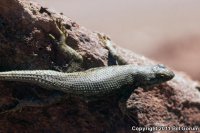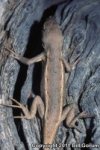| Range: |
 |
| Other Names: |
Fence Lizard, Spiny Lizard, fence swift, gray lizard, northern fence lizard, pine lizard |
| Description: |
The Prairie Lizard has spiny, keeled dorsal scales and an incomplete gular fold. It is relatively small, reaching about 2.32" SVL in males and about 2.67" SVL in females. Dorsal background color is typically brown or gray, usually accompanied by distinctive light longitudinal stripes. In some populations, the stripes are less distinct and are accompanied by crossbars or chevrons. The blue belly and throat patches are either absent or faint in some populations. In the Mescalero Sands, they have a less distinctive dorsal pattern, this population used to be known as Sceloporus undulatus tedbrowni |
| Similar Species: |
Generally smaller and has less blue on the throat and belly than S. cowlesi and S. tristichus. S. arenicolus may be confused with the Prairie Lizard where hey occur; however, S. arenicolor is slightly larger, is restricted to sand dunes/Shinnery Oak complexes, and has more than 12 scales between the medial ends of the femoral pores series. |
| Venom: |
None |
| Habitat: |
Prairie Lizards are predominantly terrestrial and occupy a wide variety of habitats including prairies, stabilized sand dunes, rocky outcrops and grasslands. |
| Behavior: |
Often bask on fallen debris, rocks, or clumps of vegetation in mornings and afternoons. |
| Hibernation: |
Brumate during the cold months, but will come out on warm days to bask. |
| Reproduction: |
Breed early April-May and females lay 1-3 clutches per year with an average of 5.5 eggs per clutch and lay more clutches depending on temperature. |
| Diet: |
Primarily insects, but they will take other arthropods. |
Sources:


|













